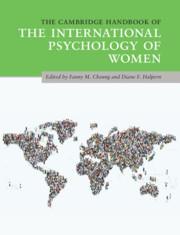Book contents
- The Cambridge Handbook of the International Psychology of Women
- The Cambridge Handbook of the International Psychology of Women
- Copyright page
- Dedication
- Contents
- Figures
- Tables
- Contributors
- Acknowledgments
- Section 1 The Underpinnings of Sex and Gender and How to Study Them
- Section 2 Developmental Perspectives of the International Psychology of Women
- Section 3 Cognitive and Social Factors
- Section 4 Work and Family Issues
- Section 5 Inequality and Social Justice
- 26 Girls, Boys, and Schools
- 27 Understanding Gender Inequality in Poverty and Social Exclusion through a Psychological Lens
- 28 Understanding Women’s Antisocial and Criminal Behavior
- 29 Sexual Assault
- 30 Intercultural Relationships, Migrant Women, and Intersection of Identities
- Section 6 Health and Well-Being
- Epilogue Some Final Thoughts and Take-Home Messages
- Index
- References
26 - Girls, Boys, and Schools
On Gender (In)equalities in Education
from Section 5 - Inequality and Social Justice
Published online by Cambridge University Press: 20 July 2020
- The Cambridge Handbook of the International Psychology of Women
- The Cambridge Handbook of the International Psychology of Women
- Copyright page
- Dedication
- Contents
- Figures
- Tables
- Contributors
- Acknowledgments
- Section 1 The Underpinnings of Sex and Gender and How to Study Them
- Section 2 Developmental Perspectives of the International Psychology of Women
- Section 3 Cognitive and Social Factors
- Section 4 Work and Family Issues
- Section 5 Inequality and Social Justice
- 26 Girls, Boys, and Schools
- 27 Understanding Gender Inequality in Poverty and Social Exclusion through a Psychological Lens
- 28 Understanding Women’s Antisocial and Criminal Behavior
- 29 Sexual Assault
- 30 Intercultural Relationships, Migrant Women, and Intersection of Identities
- Section 6 Health and Well-Being
- Epilogue Some Final Thoughts and Take-Home Messages
- Index
- References
Summary
Concerns about gender-equality in education persist in spite of substantial historical progress. We review some of the major issues occupying researchers today, while considering findings across cultures and nations. We discuss patterns of gender gaps based on cross-national assessments, research on gender stereotypes and biases in the classroom, women’s participation in STEM domains, and possible educational interventions. Some consistencies and many inconsistencies that emerge across cultures are discussed.
Keywords
- Type
- Chapter
- Information
- The Cambridge Handbook of the International Psychology of Women , pp. 375 - 389Publisher: Cambridge University PressPrint publication year: 2020
References
Suggested Readings

Michal Berkowitz is a postdoctoral researcher at the Chair for Research on Learning and Instruction at ETH Zurich. She studied psychology at Tel-Aviv University and began her career in clinical psychology. She later moved on to research in cognitive psychology, and obtained her doctoral degree in 2017 at ETH Zurich. Her doctoral research focused on cognitive predictors of advanced STEM achievements, particularly in math-intensive domains. Her research interests include spatial ability’s role in STEM learning, mathematical thinking and learning, and the interplay between working memory, intelligence, and learning. She is mother of a 12-year-old girl and a 6-year-old boy. She was born in the US, grew up in Israel and since 2009 is living in Switzerland. In addition to living in Switzerland and Israel, she spent a year living in New York. Berkowitz identifies herself as secular-Jewish.

Elsbeth Stern is a cognitive psychologist with a focus on STEM learning at various age levels. As a Professor for Learning and Instruction at ETH Zurich since 2006, she is heading the teacher education program. Stern was born and raised in Germany. After completing her doctorate at the University of Hamburg, she worked at the Max-Planck Institute for Psychological Research in Munich, and in 1994 became a Professor at the University of Leipzig. In 1997, she moved to the Max-Planck Institute for Human Development in Berlin. In more than 100 papers and several books, Stern has focused on the interaction between individual preconditions and instructional support of learning.

Sarah Isabelle Hofer is a postdoctoral researcher at the Centre for International Student Assessment (ZIB) at the TUM School of Education in Germany. From 2011 to 2016, she worked as a doctoral and later as a postdoctoral researcher in Elsbeth Stern’s group at the Chair for Research on Learning and Instruction at the ETH Zurich in Switzerland, where she received her doctoral degree in 2015. Hofer studied pedagogical psychology, reflexive social psychology, and neurocognitive psychology. Her research addresses individual, classroom, and institutional factors that contribute to educational success. With a focus on the STEM domain, she investigates how intelligence, prior knowledge, and gender interact with performance assessment and instructional methods to build theory and derive recommendations for practice. At the institutional level, she is interested in internal and external school evaluation as tools to increase educational effectiveness. She is the mother of a 2-year-old boy and a 7-year-old girl.

Anne Deiglmayr is a Full Professor for Educational Psychology in the Teacher Education Program at the University of Leipzig in Germany. She obtained her PhD in Psychology from the University of Freiburg, Germany, and has worked as a postdoctoral researcher in educational psychology and as a teacher educator in Germany and Switzerland. Her research interests include the assessment and training of experimentation skills, beliefs and biases in STEM education, and the co-construction of knowledge in dialogues between peers. She is the mother of a school-age boy and a girl, which makes this chapter on gender and education personally relevant to her.



